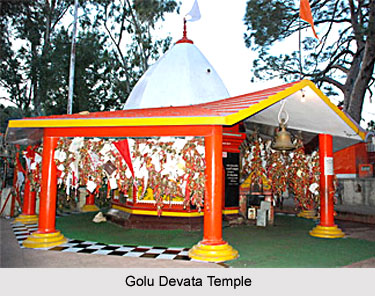 Golu Devata or Lord Golu, as popularly known, is a historical and mythological God of the Kumaun Himalaya Region in the state of Uttarakhand. Golu Devata is a much loved deity and the temple is located at 4 km from the main gate of the Binsar Wildlife Sanctuary. Lord Golu is considered as an incarnation of Gaur Bhairav (Lord Shiva) and is also worshipped across the region. He is also regarded as dispenser of justice by the devotees with extreme faiths. There is a strong belief among devotees that Golu Devata answers to all prayers. And if the person is honest and innocent then justice is imparted to him at the end. For this particular reason there are thousands of devotees that throng the temple from across the country with petitions written on papers-stamp papers and also in normal ones, each has a story to tell about a person, and pleading for justice. The subject of the plea can be anything including the domestic fights to long pending court cases. And when the prayers are answered then, they come and tie a bell in the temple compound as a mark of gratitude. The size of the bell may vary from huge ones to tiny.
Golu Devata or Lord Golu, as popularly known, is a historical and mythological God of the Kumaun Himalaya Region in the state of Uttarakhand. Golu Devata is a much loved deity and the temple is located at 4 km from the main gate of the Binsar Wildlife Sanctuary. Lord Golu is considered as an incarnation of Gaur Bhairav (Lord Shiva) and is also worshipped across the region. He is also regarded as dispenser of justice by the devotees with extreme faiths. There is a strong belief among devotees that Golu Devata answers to all prayers. And if the person is honest and innocent then justice is imparted to him at the end. For this particular reason there are thousands of devotees that throng the temple from across the country with petitions written on papers-stamp papers and also in normal ones, each has a story to tell about a person, and pleading for justice. The subject of the plea can be anything including the domestic fights to long pending court cases. And when the prayers are answered then, they come and tie a bell in the temple compound as a mark of gratitude. The size of the bell may vary from huge ones to tiny.
Temple of Golu Devata
The temple is actually located at Chitai which is 15 km away from Nainital City and perched at a height of 2000 meters above sea level. The place is beautiful and serene and is covered with misty clouds. The beauty of the temple lies in the thousands of bells of different shapes and sizes that are tied in it. The sound of the bells resonating is a fantastic feeling right with the first step that a person will take towards the stairs.
Legend of Golu Devata
From the ancient times Golu is considered as the courageous son of General of Katyuri King, Jhal Rai and Kalindra, his mother. Hal Rai was his grandfather. Historically, the origin of Golu Devata has been accepted at Champawat. His mother Kalindra is accepted to be the sister of two local deities Sem Devjyun and Harishchand Devjyun (the divine spirit of Raja Harish of the Chands). And both these deities are considered as the uncles of Lord Golu.
According to another legend he actually was Baz Bahadur`s (1638-78) army general and sacrificed his life displaying extra-ordinary valour and courage at war. And this temple was erected in his honour, 8 km from Almora City, at Chaitai.
Another popular story suggests that Golu Devata was actually killed by Binsar King because of the false doubts. He was beheaded by the king and his body fell at Gairad at Dana Golu and his head at Kaparkhan, close to modern day Binsar, which is only a few km from Almora.
Golu Devata is worshipped as an incarnation of Lord Shiva and his brother Kalva Devta as Garh Devi and Bhairava in the form of Shakti. Golu Devata is also seen as key deity (Kula/Ista) in many villages of Chamoli District. Normally nine day puja is performed to worship Lord Golu Devata, also known as Goreel Devta in Chamoli District. Golu Devata is offered milk, ghee, halwa, curd, poori, pakauri. Sacrifice is also a part of the ritual in which two male goats, black in colour, are offered to the lord. The sacrificed goat is received as prasada for pooja. Golu Devata is considered as God of justice and prayed with great enthusiasm and pride. Golu Devata is offered white clothes, white shaal and pagari.
There are many temples of Golu Devata in Kumaon, and the most popular are at Chitai, Champawat, Ghorakhal.
Tourist Spots around Golu Devata Temple:
Binsar Wildlife Santuary: The Binsar Wildlife Sanctuary`s gate is 4 km away from the temple.
Sainik School: On the way to Golu Devata, a tourist can look to visit the one can visit the Sainik School, a one of its kind of school where boys are prepared to join the armed forces. The physical and the mental training being rigorous, prepare the student for the challenging life ahead.









